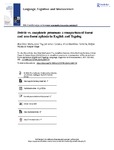Deictic vs. anaphoric pronouns: a comparison of fluent and non-fluent aphasia in english and tagalog

View/
Use this link to cite
http://hdl.handle.net/2183/40994
Except where otherwise noted, this item's license is described as Creative Commons Attribution 4.0 International License (CC-BY 4.0)
Collections
- Investigación (FCS) [1293]
Metadata
Show full item recordTitle
Deictic vs. anaphoric pronouns: a comparison of fluent and non-fluent aphasia in english and tagalogAuthor(s)
Date
2024-07-18Citation
Thy ADM, Gerona J, Martínez-Ferreiro S, Popov S, Boye K. Deictic vs. anaphoric pronouns: a comparison of fluent and non-fluent aphasia in english and tagalog. Lang Cogn Neurosci. 2024 Jul 18;39(7):909-923.
Abstract
[Abstract] Deictic pronouns refer directly to the extralinguistic world (as in Stop her!), while anaphoric pronouns refer to elements introduced in discourse (as in My best friend is Mary. John adores her.). The distinction is central to linguistic theory and may be central also for understanding aphasia. This paper compares the production of deictic and anaphoric pronouns in fluent aphasia and non-fluent aphasia. It does so both for English and for Tagalog, which allows extensive omission of pronominal arguments. For both languages, the results show a dissociation between deictic and anaphoric pronouns. Non-fluent aphasic speech displays a lower proportion of anaphoric pronouns to non-pronouns than non-brain-damaged speech, while the proportion of deictic pronouns to non-pronouns is either not different (Tagalog) or higher (English). In contrast, fluent aphasic speech displays a higher proportion of deictic pronouns to non-pronouns, while the proportion of anaphoric pronouns is either not different (Tagalog) or lower (English).
Keywords
Deixis
Anaphora
Pronouns
Aphasia
Tagalog
Anaphora
Pronouns
Aphasia
Tagalog
Editor version
Rights
Creative Commons Attribution 4.0 International License (CC-BY 4.0)
ISSN
2327-3798






